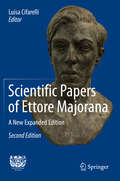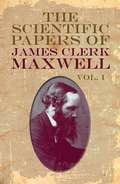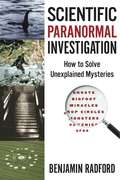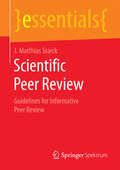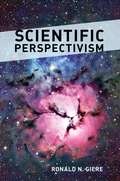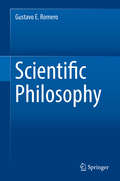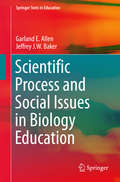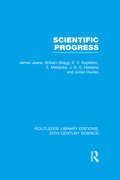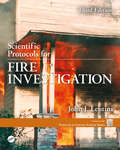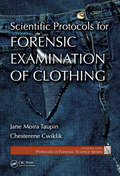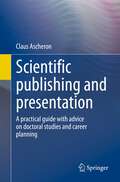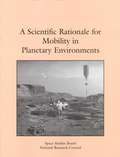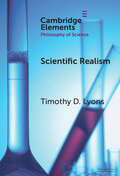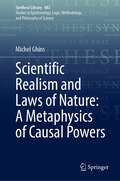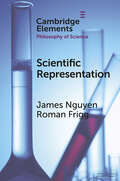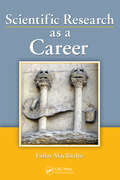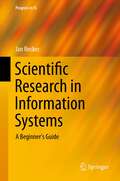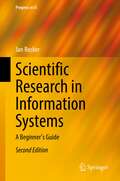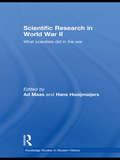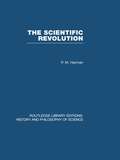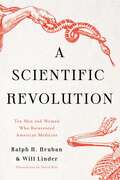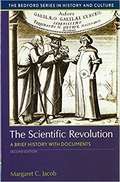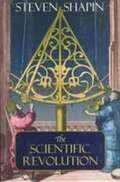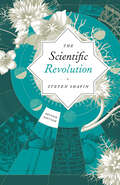- Table View
- List View
Scientific Papers of Ettore Majorana: A New Expanded Edition
by Luisa CifarelliThis book presents in full the work of the Italian theoretical physicist Ettore Majorana and explains its impacts, which are still being felt. It opens with a contribution by A. Zichichi that considers in depth the scientifi c genius of Majorana. This introductorychapter is followed, in chronological order, by the eleven scientifi c papers by this great scientist, in most cases translated into English for the fi rst time. Each paper is accompanied by a comment from an expert in the fi eld in question. Although very few in number, Majorana’s papers constitute a heritage of undeniable value and extraordinary scientifi c meaning, since they laid the foundations for research fi elds that remain topical today. With this in mind, two additional contributions on ongoing developments in these research fi elds are included: one on neutrino physics and the other on Majorana fermions in condensed matter. The volume closes with a note on Majorana’s life until his ill-fated disappearance.
The Scientific Papers of James Clerk Maxwell, Vol. I
by James Clerk MaxwellOne of the greatest theoretical physicists of the 19th century, James Clerk Maxwell is best known for his studies of the electromagnetic field. The 101 scientific papers of this two-volume set, arranged chronologically, testify to Maxwell's profound scientific legacy and include the preliminary explorations that culminated in his most famous work, A Treatise on Electricity and Magnetism. One of the nineteenth century's most significant papers, "A Dynamical Theory of the Electromagnetic Field," appears here, along with similarly influential expositions of Maxwell's dynamical theory of gases. The author's extensive range of interests is well represented, from his discussions of color blindness and the composition of Saturn's rings to his essays on geometrical optics, ether, and protecting buildings from lightning. His less technical writings are featured as well, including items written for the Encyclopedia Britannica and Nature magazine, book reviews, and popular lectures. Striking in their originality, these papers offer a wealth of stimulating and inspiring reading to modern students of mathematics and physics.
Scientific Paranormal Investigation: How to Solve Unexplained Mysteries
by Benjamin RadfordThis book is about the scientific methods used to investigate mysteries with real life case studies and how they were solved.
Scientific Peer Review: Guidelines for Informative Peer Review (essentials)
by J. Matthias StarckJ. Matthias Starck comprehensively guides the reader in this essential through all steps of writing an expert review for a scientific journal. It is built on a succinct analysis how science works, how science is communicated and how science is published. It provides a critical guide how to write good, informative and fair peer reviews. The author presents a critical discussion of different peer review procedures and their alternatives, explains ethical guidelines as well as the dark sides of scientific publishing. So this essential helps the reader to perform better in the existing system and to contribute to its further development and improvement.
Scientific Perspectivism (Science And Its Conceptual Foundations Ser.)
by Ronald N. GiereMany people assume that the claims of scientists are objective truths. But historians, sociologists, and philosophers of science have long argued that scientific claims reflect the particular historical, cultural, and social context in which those claims were made. The nature of scientific knowledge is not absolute because it is influenced by the practice and perspective of human agents. Scientific Perspectivism argues that the acts of observing and theorizing are both perspectival, and this nature makes scientific knowledge contingent, as Thomas Kuhn theorized forty years ago.Using the example of color vision in humans to illustrate how his theory of “perspectivism” works, Ronald N. Giere argues that colors do not actually exist in objects; rather, color is the result of an interaction between aspects of the world and the human visual system. Giere extends this argument into a general interpretation of human perception and, more controversially, to scientific observation, conjecturing that the output of scientific instruments is perspectival. Furthermore, complex scientific principles—such as Maxwell’s equations describing the behavior of both the electric and magnetic fields—make no claims about the world, but models based on those principles can be used to make claims about specific aspects of the world. Offering a solution to the most contentious debate in the philosophy of science over the past thirty years, Scientific Perspectivism will be of interest to anyone involved in the study of science.
Scientific Philosophy
by Gustavo E. RomeroThis textbook presents the basics of philosophy that are necessary for the student and researcher in science in order to better understand scientific work. The approach is not historical but formative: tools for semantical analysis, ontology of science, epistemology, and scientific ethics are presented in a formal and direct way. The book has two parts: one with the general theory and a second part with application to some problems such as the interpretation of quantum mechanics, the nature of mathematics, and the ontology of spacetime. The book addresses questions such as "What is meaning?", "What is truth?", "What are truth criteria in science?", "What is a theory?", "What is a model?" "What is a datum?", "What is information?", "What does it mean to understand something?", "What is space?", "What is time?", "How are these concepts articulated in science?" "What are values?" "What are the limits of science?", and many more. The philosophical views presented are "scientific" in the sense that they are informed by current science, they are relevant for scientific research, and the method adopted uses the hypothetical-deductive approach that is characteristic of science. The results and conclusions, as any scientific conclusion, are open to revision in the light of future advances. Hence, this philosophical approach opposes to dogmatic philosophy. Supported by end-of-chapter summaries and a list of special symbols used, the material will be of interest for students and researchers in both science and philosophy. The second part will appeal to physicists and mathematicians.
Scientific Process and Social Issues in Biology Education
by Garland E. Allen Jeffrey J. W. BakerThis book complements fact-drive textbooks in introductory biology courses, or courses in biology and society, by focusing on several important points: (1) Biology as a process of doing science, emphasizing how we know what we know. (2) It stresses the role of science as a social as well as intellectual process, one that is always embedded in its time and place in history. In dealing with the issue of science as a process, the book introduces students to the elements of inductive and deductive logic, hypothesis formulation and testing, the design of experiments and the interpretation of data. An appendix presents the basics of statistical analysis for students with no background in statistical reasoning and manipulation. Reasoning processes are always illustrated with specific examples from both the past (eighteenth and nineteenth century) as well as the present. In dealing with science and social issues, this book introduces students to historical, sociological and philosophical issues such as Thomas Kiuhn's concept of paradigms and paradigm shifts, the social-constructions view of the history of science, as well as political and ethical issues such human experimentation, the eugenics movement and compulsory sterilization, and religious arguments against stem cell research and the teaching of evolution in schools. In addition to specific examples illustrating one point or another about the process of biology or social-political context, a number of in-depth case studies are used to show how scientific investigations are originated, designed, carried out in particular social/cultural contexts. Among those included are: Migration of monarch butterflies, John Snow's investigations on the cause of cholera, Louis Pasteur's controversy over spontaneous generation, the mass extinction of the dinosaurs, and the Tuskegee syphilis experiment.
Scientific Progress (Routledge Library Editions: 20th Century Science)
by James Jeans J.B.S. Haldane William Bragg E.V. Appleton E. Mellanby Julian S. HuxleyFirst published in 1936, this volume contains six of the Halley Stewart Lectures – originally founded "For Research towards the Christian Ideal in All Social Life" – by some of the greatest of English scientists of the mid-20th century, each a leading authority in his respective field: cosmology, physics, meteorology, medicine and genetics. The final lecture considers the relationship between scientific knowledge and human ideals, commenting on the paradox that a century which produced such scientific advance also witnessed the most concentrated period of social, economic and political turmoil in world history.
Scientific Protocols for Fire Investigation, Third Edition (Protocols in Forensic Science #5)
by John J. LentiniScientific Protocols for Fire Investigation, Third Edition focuses on the practical application of fundamental scientific principles to determine the causes of fires. Originally published in 2006, the First Edition was very well received by fire investigators and those who work with them. Since fire investigation is a rapidly evolving field—driven by new discoveries about fire behavior—the Second Edition was published in late 2012. This latest, fully updated Third Edition reflects the most recent developments in the field. Currently, serious research is underway to try to understand the role of ventilation in structure fires. Likewise, there is improved understanding of the kinds of errors investigators can make that lead to incorrect determinations of the causes of fires. In addition to the scientific aspects, the litigation of fire related events is rapidly changing, particularly with respect to an investigator's qualifications to serve as an expert witness. This book covers these latest developments and ties together the changing standards for fire investigations with the fundamental scientific knowledge presented in the early chapters of the book. The book is intended for those individuals who have recently entered the field of fire investigation, and those who are studying fire investigation with a plan to become certified professionals. In addition, professionals in the insurance industry who hire fire investigators will find this an invaluable resource. Insurance companies have sustained significant losses by hiring individuals who are not qualified, resulting in cases being settled or lost at a cost of millions. Insurance adjusters and investigators will learn to recognize quality fire investigations and those that are not up to today's standards. Lastly, this book is also for the many attorneys who litigate fire cases. Written with language and terms that make the science accessible even to the non-scientist, this new edition will be a welcome resource to any professional involved in fire and arson cases.
Scientific Protocols for Forensic Examination of Clothing (Protocols in Forensic Science)
by Jane Moira Taupin Chesterene CwiklikWhen a crime or other incident takes place, clothing items are often present or left behind, and can become directly involved in the case itself. Items of clothing are thus one of the most common types of exhibit examined in court. They can provide valuable information in cases of violent crimes, such as homicide or rape, as well as in burglary, ro
Scientific publishing and presentation: A practical guide with advice on doctoral studies and career planning
by Claus AscheronThe aim of this book is to help young scientists improve their oral and written communication skills and thus better sell their own results. This book is not a scientific textbook. It addresses the often forgotten question of how to present one's scientific results effectively and convincingly in talks and publications. In addition, this book provides background knowledge on the process of scientific publishing and scientific customs. The recommendations help to develop a good and effective work and communication style that will benefit you throughout your life and bring satisfaction in your work. Furthermore, concrete advice is given on how to write and successfully defend a dissertation and how to take the first steps in career planning.
Scientific Rationale for Mobility in Planetary Environments
by Committee on Planetary Lunar ExplorationInformation on Scientific Rationale for Mobility in Planetary Environments
Scientific Realism (Elements in the Philosophy of Science)
by Timothy D. LyonsThe scientific realism debate directly addresses the relation between human thought and the reality in which it finds itself. A core question: can we justifiably believe that science accurately describes the reality that lies beneath the limits of human experience? Exploring this question, the Element begins at the most foundational level of scientific realism, the endeavor to justify belief in the existence of unobservables by way of abduction. Raising anti-realist challenges, some much discussed in the literature but also some generally overlooked, it works its way toward more refined variants of scientific realism. Because it takes scientific realism to be the default position of many – scientific realists themselves often assuming it is the default position of scientists – the emphasis will be on the challenges. Those challenges will also motivate the variants of scientific realism traced. The Element concludes with an articulation of the author's own position, Socratic scientific realism.
Scientific Realism and Laws of Nature: A Metaphysics of Causal Powers (Synthese Library #483)
by Michel GhinsThis book addresses central issues in the philosophy and metaphysics of science, namely the nature of scientific theories, their partial truth, and the necessity of scientific laws within a moderate realist and empiricist perspective. Accordingly, good arguments in favour of the existence of unobservable entities postulated by our best theories, such as electrons, must be inductively grounded on perceptual experience and not their explanatory power as most defenders of scientific realism claim. Similarly, belief in the reality of dispositions such as causal powers which ground the natural necessity of scientific laws must be based on experience. Hence, this book offers a synthetic presentation of an original metaphysics of science, namely a metaphysics of properties, both categorical and dispositional, while at the same time opposing strong versions of necessitarism according to which laws are true in all possible worlds.The main theses and arguments are clearly presentedin a non-technical way. Thus, on top of being of interest to the specialists of the topics discussed, it is also useful as a textbook in courses for third year and more advanced university students.
The Scientific Renaissance 1450-1630
by Marie Boas HallWhile scientific inquiry has its roots in both Far Eastern and Indo-European cultures, the revolutionary ideas that made modern scientific achievements possible occurred initially in Europe. This stimulating, illuminating, and thoughtfully presented work explores the early stages of this scientific revolution, beginning with the rediscovery of Greek ideas in the mid-15th century and culminating with Galileo's brilliant Dialogue on the Two Chief Systems of the World in 1630. Noted historian of science Marie Boas Hall first gives a general account of scientific thought in the mid-1400s, then examines the Copernican revolution and the anatomical work of Vesalius and his contemporaries, the impact of chemical medicine and the efforts of the Swiss physician and alchemist Paracelsus. Also here are insightful discussions of Harvey's discovery of the circulatory system, the work of Kepler, the effects of Galileo's telescopic discoveries, and other topics. A series of accompanying illustrations -- among them a Ptolemaic map, examples of Renaissance engineering, and portraits of Francis Bacon, Tycho Brahe, Vesalius, Kepler, and Galileo -- enhance this scholarly and informative work. A valuable reference book for students of the history of science, The Scientific Renaissance 1450-1630 is "good, sound, academic stuff . . . interesting even to those for whom it is not required reading." -- New Statesman.
Scientific Research as a Career
by Finlay MacRitchieDescribing the philosophy of the scientific method and the training and professional characteristics needed for a successful career, Scientific Research as a Career is a comprehensive "how-to" guide for the aspiring scientist. Based on the author's experience both as a scientist in a research organization and as a university mentor, the book covers
Scientific Research in Information Systems
by Jan ReckerThis book is designed to introduce doctoral and other higher-degree research students to the process of scientific research in the fields of Information Systems as well as fields of Information Technology, Business Process Management and other related disciplines within the social sciences. It guides research students in their process of learning the life of a researcher. In doing so, it provides an understanding of the essential elements, concepts and challenges of the journey into research studies. It also provides a gateway for the student to inquire deeper about each element covered . Comprehensive and broad but also succinct and compact, the book is focusing on the key principles and challenges for a novice doctoral student.
Scientific Research in Information Systems: A Beginner's Guide (Progress in IS)
by Jan ReckerThis book introduces higher-degree research students and early career academics to scientific research as occurring in the field of information systems and adjacent fields, such as computer science, management science, organization science, and software engineering. Instead of focusing primarily on research methods as many other textbooks do, it covers the entire research process, from start to finish, placing particular emphasis on understanding the cognitive and behavioural aspects of research, such as motivation, modes of inquiry, theorising, planning for research, planning for publication, and ethical challenges in research. Comprehensive but also succinct and compact, the book guides beginning researchers in their quest to do scholarly work and to assist them in developing their own answers and strategies over the course of their work. Jan Recker explains in this book the fundamental concepts that govern scientific research and then moves on to introduce the basic steps every researcher undertakes: choosing research questions, developing theory, building a research design, employing research methods, and finally writing academic papers. He also covers essentials of ethical conduct of scientific research. This second edition contains major updates on all these elements plus significant expansions on relevant research methods such as design research and computational methods, a rewritten and extended chapter on theory development, and expansions to the chapters on research methods, scientific publishing, and research ethics. A companion website provides pedagogical materials and instructions for using this book in teaching.
Scientific Research In World War II: What scientists did in the war
by Ad Maas Hans HooijmaijersThis book seeks to explore how scientists across a number of countries managed to cope with the challenging circumstances created by World War II. No scientist remained unaffected by the outbreak of WWII. As the book shows, there were basically two opposite ways in which the war encroached on the life of a scientific researcher. In some cases, the outbreak of the war led to engagement in research in support of a war-waging country; in the other extreme, it resulted in their marginalisation. The book, starting with the most marginalised scientist and ending with those fully engaged in the war-effort, covers the whole spectrum of enormously varying scientific fates. Distinctive features of the volume include: a focus on the experiences of ‘ordinary’ scientists, rather than on figureheads like Oppenheimer or Otto Hahn contributions from a range of renowned academics including Mark Walker, an authority in the field of science in World War II a detailed study of the Netherlands during the German Occupation This richly illustrated volume will be of major interest to researchers of the history of science, World War II, and Modern History.
The Scientific Revolution (Routledge Library Editions: History & Philosophy of Science)
by Peter HarmanOriginally published in 1983.This volume outlines some of the important innovations in astronomy, natural philosophy and medicine which took place in the sixteenth and seventeenth centuries, and shows how the transformation in world-view during the period was affected by broader historical terms. Themes such as the spread of Puritanism, the decline of witchcraft and magic, and the incorporation of science as an integral part of the intellectual milieu of late seventeenth-century England.
A Scientific Revolution: Ten Men and Women Who Reinvented American Medicine
by Dr. Ralph H. Hruban William LinderA prismatic examination of the evolution of medicine, from a trade to a science, through the exemplary lives of ten men and women. Johns Hopkins University, one of the preeminent medical schools in the nation today, has played a unique role in the history of medicine. When it first opened its doors in 1893, medicine was a rough-and-ready trade. It would soon evolve into a rigorous science. It was nothing short of a revolution. This transition might seem inevitable from our vantage point today. In recent years, medical science has mapped the human genome, deployed robotic tools to perform delicate surgeries, and developed effective vaccines against a host of deadly pathogens. But this transformation could not have happened without the game-changing vision, talent, and dedication of a small cadre of individuals who were willing to commit body and soul to the advancement of medical science, education, and treatment. A Scientific Revolution recounts the stories of John Shaw Billings, Max Brödel, Mary Elizabeth Garrett, William Halsted, Jesse Lazear, Dorothy Reed Mendenhall, William Osler, Helen Taussig, Vivien Thomas, and William Welch. This chorus of lives tells a compelling tale not just of their individual struggles, but how personal and societal issues went hand-in-hand with the advancement of medicine.
The Scientific Revolution: A Brief History with Documents (The Bedford series in History and Culture)
by Margaret JacobThe Scientific Revolution highlights the difficulty of engaging, discarding, or assimilating religious paradigms in the course of scientific development. Jacob's introduction outlines the trajectory of the Scientific Revolution and argues that the revival of ancient texts in the Renaissance and the upheaval of the Protestant Reformation paved the way for science.
The Scientific Revolution
by Steven ShapinA historical exploration of the origins of the modern scientific worldview. The author rejects the idea that there was anything like a "revolution" in early modern science, instead asserting that scientific knowledge was advanced through social practices for social purposes, and was met as much with skepticism and rejection as with celebration and praise. Annotation c. by Book News, Inc. , Portland, Or.
The Scientific Revolution (science.culture)
by Steven Shapin“There was no such thing as the Scientific Revolution, and this is a book about it.” With this provocative and apparently paradoxical claim, Steven Shapin begins his bold, vibrant exploration of the origins of the modern scientific worldview, now updated with a new bibliographic essay featuring the latest scholarship. “An excellent book.”—Anthony Gottlieb, New York Times Book Review “Timely and highly readable. . . . A book which every scientist curious about our predecessors should read.”—Trevor Pinch, New Scientist “Shapin's account is informed, nuanced, and articulated with clarity. . . . This is not to attack or devalue science but to reveal its richness as the human endeavor that it most surely is. . . . Shapin's book is an impressive achievement.”—David C. Lindberg, Science “It's hard to believe that there could be a more accessible, informed or concise account. . . . The Scientific Revolution should be a set text in all the disciplines. And in all the indisciplines, too.”—Adam Phillips, London Review of Books
